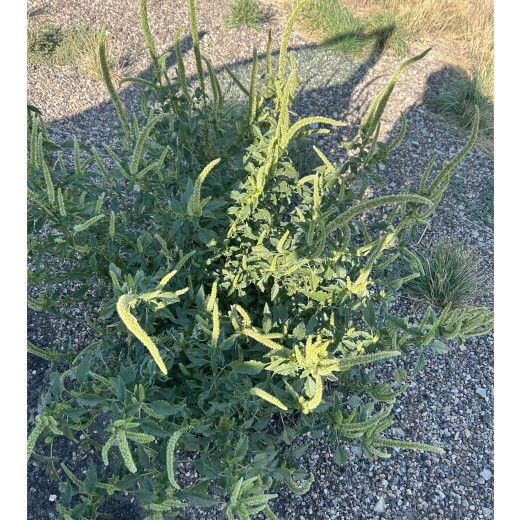New Population of Palmer Amaranth Detected
Palmer amaranth (Amaranthus palmeri) was confirmed for the first time in Carter County, Montana in September 2024. This is the third confirmed occurrence of this plant in Montana. Be on the lookout for this species and its close relative waterhemp (Amaranthus tuberculatus) this fall.
Palmer Amaranth and Waterhemp in Montana
Palmer amaranth (Amaranthus palmeri) and waterhemp (Amaranthus tuberculatus) are both pigweed species that have very limited known distribution in Montana. Both species have developed genotypes resistant to multiple herbicide modes of action. If they become established, these two species will have a large economic impact on Montana agriculture. Both weeds have the potential to establish in warm season crops such as corn and millet, and also irrigated sugarbeets, cereal, and pulse crops, but have also been associated with birdfeed. In September 2024 one male, flowering Palmer amaranth plant was found growing on a roadside in Carter County. The plant was removed from the site and no seeds were produced. This detection follows two in 2023 in Daniels and Toole Counties. To date, fewer than ten Palmer amaranth plants have been found in Montana, and all were removed from their sites prior to seed production.
 |
Palmer amaranth plant growing on the roadside in Carter County, September 2024. Photo credit Amanda Williams, MSU Carter County Extension
Two waterhemp populations have also been found in eastern Montana in recent years. One was detected in an irrigated durum field in Roosevelt County in 2020, and a few plants were found in a sugarbeet field in Prairie County in 2021. Now is a good time of year to scout fields for Palmer amaranth and waterhemp because these warm season pigweeds are best identified when flowering. Special attention should be given to scouting warm season forages and irrigated fields. Look for large pigweeds with long, thin inflorescences compared with more common relatives like redroot pigweed.
Long thin inflorescence of Palmer amaranth. Note the numerous yellow anthers suggesting it is a male plant.
Photo credit Amanda Williams, MSU Carter County Extension
Early detection and rapid response are critical to contain these weeds and prevent populations from establishing, so learn to identify them, take action to manage and control spread as needed, and learn to recognize potential vectors. Identification can be difficult, but the MontGuides and resources linked below can help identify the different pigweeds. Contact your local Extension office [montana.edu] or agronomist if you suspect you have found either of these species or if you have questions about pigweed identification.
Resources for Identification and Management
Idaho detects quagga mussels in Snake River
Boise, Idaho - The Idaho State Department of Agriculture (ISDA) announced the detection of a small number of quagga mussels in the Twin Falls area of the Snake River.
Quagga mussels were first identified in the Twin Falls area in September 2023. Working with a broad group of partners, the ISDA rapidly implemented a treatment plan which includes extensive on-going monitoring.
“We have a strong invasive species program in place to monitor our waterways for quagga mussels, and we are prepared to respond with a treatment plan with minimal impacts to the public. While we never want to see confirmation of quagga mussels, we know that pest eradication is rarely ‘one and done.’ Since the first detection in 2023, ISDA has conducted more water sampling, ran more inspections stations, increased statewide communications, added manpower, and worked with more partners. We have made significant progress, and now we must focus on the next phase of eradication. ISDA and the many partners who have helped in countless ways will continue to push for full eradication. We know this next phase is pivotal,” ISDA Director Chanel Tewalt said.
In 2023, ISDA implemented a treatment of the river with a chelated copper product. It was the first treatment of this type and scale ever attempted in North America. Sampling results indicate the chelated copper treatment was effective in reducing the mussel population.
Since 2023, the ISDA has taken nearly 300 samples in the affected stretch of river and over 3,000 samples statewide throughout the 2024 season, doubling routine monitoring samples for the year. Current sample results show a decreased quagga mussel presence in the affected stretch of river compared to the pre-treatment survey in 2023.
Recent positive detection locations include in the Shoshone Falls pool, Pillar Falls and the Twin Falls Reservoir behind Twin Falls hydroelectric facility. Quagga mussel reproduction is more active in warmer water temperatures, making late summer the most likely time to detect the mussels in the Snake River.
ISDA is planning another strategic treatment for the affected stretch of river. Through extensive surveying this year – double the amount Idaho has ever conducted – the agency has even more information taking on the infestation this year.
|